How to Gamify Parking
By Chelsea Webster
First and foremost – what the heck is gamification? Great question. It’s the process of taking something that already exists (an app, or a website, for example), and integrating game mechanics to it, so that you end up with an augmented version that people are more motivated to use1. It’s not building a new game – it’s making whatever you’re already doing into a game.
To better understand the concept, consider a few common elements that almost every gamified system has: points, levels, achievements, a leaderboard, and rewards2. No matter what app or online games you’ve played, consider how these elements add up to pique your curiosity.
Let me give you a quick example. I’ve used a customer relationship management tool that utilizes gamification (https://crm.me/gamification/). As a new user, I log in and have a grand total of 0 points. As I click on different tabs and features, the system awards me points. There’s a progress bar for how many tutorials I’ve watched, so I plug away at that because I can see exactly how far I’ve come and what’s left to be done. It’s satisfying to get that kind of feedback. I build up my understanding of the application’s functionality and learn to update customer information and make notes in profiles. After I do this a couple of times, I earn enough points to move from level 1 to level 2. With that level up, I’ve unlocked a new task and can send email to customers, earning me a badge! A badge! Yes! What a great reward!
And imagine if the rewards that you get keep getting more appealing. It starts off with some trinkets or badges, moves up to earning power, access to locked content, and finally culminates in an elevated status in the game3. I’m not even in sales, but I definitely compared my badge count to that of my coworkers’ more than once. And that, my friends, is gamification in action.
But why does gamification work?
Psychology. It takes our desire for social contact, community, acceptance, and achievement and turns it into an achievable target. There are two main psychological theories in play here:
- Theory of 16 basic desires: basically a list of what factors motivate people and make them happy. It includes saving, social status, idealism, order, social contact, vengeance, and curiosity4(to name a few) – and most of these integrate easily into an online game you share with others.
- Self-determination theory: motivation to act is both intrinsic and extrinsic, and hinges on social circumstances and task characteristics5. So if gamification of something promotes socially valued tasks like caring for the environment (intrinsic motivation), is easy to do, plus offers rewards for completing it (extrinsic motivation), logically people will be motivated to use it.
So now that the psychology is all laid out, what’s needed to successfully gamify something? Well, the first step is game mechanics.
What are game mechanics?
Game mechanics are the rules of the game, the nuts and bolts of development, and instructions on how things work and what happens next after each action you take. There are 10 fundamental game mechanics, and using two or more of them in combination is what takes that regular app and makes it gamified. The fundamentals are:
- Fast feedback
- Transparency
- Short and long term goals
- Badges
- Levelling up
- Onboarding (a way to learn something new)
- Competition
- Collaboration (working in teams)
- Community (how is everyone else doing?)
- Points6
This matters, as any attempt at gamification that doesn’t involve at least some of the above won’t work. I’ll come back to this a bit later when going over how gamification can be applied to parking.
The Kaleidoscope of Effective Gamification
Another way to look at an effective use of gamification is that it has several layers, building on top of each other. Check out the diagram below for a visual on what I’m about to describe7. The core and first layer, critical to the success of any attempt at gamification, is building objectives you’re looking to achieve. From there, both intrinsic motivation and extrinsic motivation are required to get people to play along. This goes back to the beginning of the article, when I talked about self-determination theory (remember?) and the need to motivate people to participate and reward them for doing so.
The next layer is integrating actions, challenges, and achievements into an actual experience. And once you build the actual app or site or whatever virtual experience you’re creating, it’s important to have a good design. It’s the user’s lens with which they see the end goal, so make sure you’re not just putting lipstick on a pig here.
Finally, gamification really does mean making something into a game. And games should be fun. So you’ve got the outer shell as the perceived layer of fun, which includes things like audio, visuals, and an overall experience. If the game isn’t fun, and users don’t like interacting with it, they sure aren’t going to use it. And that’s definitely not the point of putting all the effort into gamifying something.
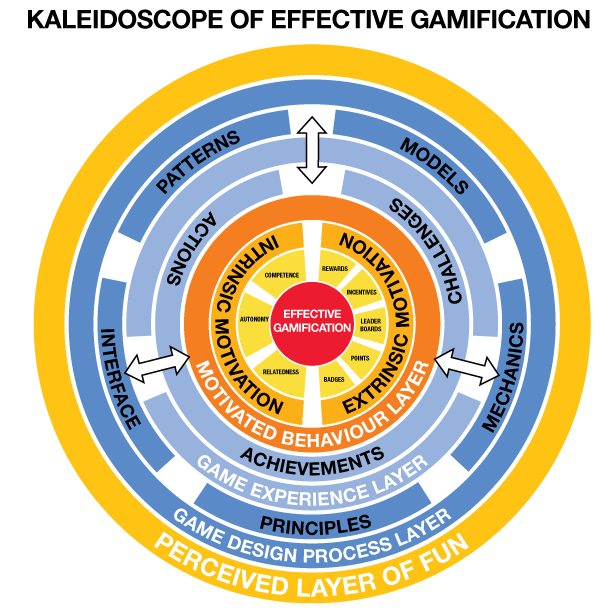
This is all well and good, but makes a lot more sense with some examples. Let’s look at some ways that gamification has been successfully applied.
Examples of Gamification in Action
Sales:With gamification, you can set goals for employees, track performance (which everyone can see), compare themselves to coworkers, give instant feedback, and offer rewards for successful completion of tasks. Check out https://www.gameffective.com/for a pre-built app and some case studies on how well this technique actually works. To take this even a step further, you can assign points to specific behaviours, like calling customers or sending emails.
Learning:Introduction and onboarding programs can be overwhelming. Ensure your learners feel like they are making progress with game mechanics like a progress bar and leveling up each time they tackle a new concept. As a bonus, gamified virtual learning reduces overhead costs of instructors and provides detailed tracking and updates on how participants are doing8. This also provides an easy way to go back and review materials, earning more points or a better score while reinforcing learning.
Customer loyalty:You can also groom customers to take specific actions if you reward them. If your business already requires an online account, add a referral button and award prizes for sending their friends to your business. As another example, you can try to encourage participation by showing how frequently other customers are using the service or offering prizes for the highest spend/score/use9.
Health & wellness:Encouraging staff, students, or customers to be more active and eat healthier is a daunting task. Providing a gamified portal to motivate, encourage (with specific goals and activities), and track progress can be a successful strategy. Daily reporting of active minutes, foods consumed, assigning teams, and social broadcasting of results are all applications of game mechanics that have worked at companies like Pfizer and Quest Diagnostics. Employers reduce benefit costs and end up with more motivated staff, so it’s a win for them as well10.
Training programs:Making sure employees understand and adhere to workplace guidelines is critical. Compliance is a chore to teach, but with gamification you can reward employees with badges or points for completing the lessons11. A competition for who can enhance their skills the fastest or score the highest on compliance tests is a great way to provide this type of training. Instilling specific, desirable behaviours is easy when employees see tangible rewards.
Transit:Several programs have been implemented around the world testing out the viability and popularity of gamifying transit. There’s a basic strategy on how you can gamify transit, as depicted in the diagram below12. It shows that when people ride transit (you can specify when, where and what kind), they are rewarded with points. The points accumulate in the rider’s account, and can be cashed in for a reward like cash or discounts of goods and services.

Here are a few real life examples of this process in action:
SASABus in Italy: Using existing smart city technology (Bluetooth and Onyx Beacons) to track bus usage13. Each kilometer a user travels by bus (extra points for eco buses) is tracked and an aggregated total score is publicly visible. You can share your accomplishments on social media, and if you earn enough points you even get to participate in special challenges. The underlying goal here is to encourage environmental stewardship by taking public transportation.
BART in San Francisco: Solving overuse and the extreme peaks and valleys in ridership. Participants register their transit card to earn BARTPerks, and points accumulate each time you scan the card to board public transit. You can use your points to win cash or discounts on future transit passes. The program is funded by the federal highway administration grant, and was to have published results late in 201714.
INSINC in Singapore: A 3 pronged public transit demand management plan. Since increasing the supply of transit is flat out geographically impossible, Singapore is implementing quotas, on-demand pricing, and creating huge inconveniences for non-conformance. Rewards are provided for anyone taking transit at off-peak times, which can be redeemed for cash or raffle entries. Social motivation is proving quite effective which users inviting friends online and leaning INSINC facts. Some lessons learned in this program are that registration has to be simple, and that people respond better to bigger rewards (even if there is a lower probability of obtaining them) 15. Overall, they’ve seen about 11% decrease in ridership over peak periods, so it’s definitely proving to be effective.
Awesome! Transit is meant for gamification! But…
Can you go too far trying to gamify transit?
Of course. There are innumerable instances where a great idea goes over the deep end, making it impractical for beginners or anyone outside the ultra-eager, early adopter category.
One example is the Mobility Speculations project called Blue Challenge, which seeks to find out if you can gamify urban transit. It suggests installing sensors around an entire city, assigning people mobility cards, and tracking every time people move16. Points are automatically assigned which can be collected and redeemed for… stuff. (I’ve included their point guide below.) The idea is that to earn more points, you will take alternate forms of transportation. It becomes even more complex by adding mini-games, user statuses, unlocking privileges, and designing challenges for others.
Doesn’t this seem just too complicated for people to get on board (pun intended)? Keep that lesson in mind if you decide to implement your own gamification strategy. Let’s all follow the US Navy’s lead and KISS (keep it simple, stupid) 17.
Blue Challenge point guide
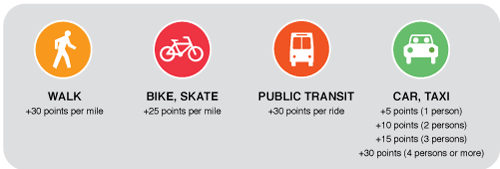
Another (bad) example comes from researchers in LA who appear to be jumping on the (outdated) Pokémon band wagon with their proposed gamification strategy. The strategy is called Incenti-Max, and involves users riding the metro, visiting points of interest, and accomplishing tasks along the way, all in the name of earning points. Top point achievers capture a bus station for a month and have their photo displayed in-app as the captor18. No thanks – said every baby boomer and gen x-er everywhere. And just for reference, I, as a millennial, also have zero interest in participating in that. We have something in common after all 😉
Gamification Belongs in Parking
So now that everyone is on the same page about what gamification is, let me explain why it has a place in the parking industry.
First, engagement among customers increases. It’s a challenge to collect feedback from customers, and even more difficult to measure effectiveness of your marketing efforts. With a gamified app, you can see exactly who is interested and how often they are participating. There is a ton of customer data to be gathered, analyzed, and acted upon.
Second, it provides an entertaining and interactive way to share information with users. You could include a video or a quiz informing them about rates, permits, special offers, closures, or anything else you need to communicate. Offer rewards for taking the desired action and completion rates go way up.
Third, it builds loyalty to a particular parking location. Much the same way Shoppers Optimum Points or Husky Rewards or any other loyalty program works, you become the vendor of choice. Providing game mechanics like a goal to work towards, plus a progress bar showing how close you are to a reward, encourages repeat business.
Finally, games are fun because they generate a (small) amount of pleasure in the player’s brain. Accomplishing tasks and receiving praise for doing so stimulates chemical reactions that drive happiness19. One challenge that we almost always have in parking is that it’s mundane at best – a necessary evil to some. But what if gamification offered a way to make parking fun and enjoyable?
Prove It.
Just because I said gamification has a place in parking, that doesn’t mean you (or your customers) care. Let me offer some data to support my claim. The City of Los Angeles recently conducted a survey around implementing gamification in their transit system. They found that the majority of riders would rank their likeliness of taking advantage of a rewards system a 4 or 5 out of 520.
What else could you apply gamification to?
Turns out, you can gamify almost anything. Find out through this link how it works at a zoo or theme park https://www.ojoo.com/gamification-and-augmented-reality-in-theme-parks-zoos-fresh-solutions/.
And here’s where you can learn how to encourage people to cycle more. https://doi.org/10.1016/j.trpro.2016.12.065.
Or, encourage more sustainable forms of transportation. Maybe even best of all, you can teach driving safety to new drivers and have them encourage their friends to practice these principles.
Motivated to move forward with gamification in your operation? Let me introduce you to a universal framework to help you plan out the components of the system.
Octalysis
Umm… what was that? It turns out there is an expert author and speaker on actionable gamification (Yu-Kai Chou), and he developed a gamification framework called Octalysis. His philosophy is to design content to engage people, and his framework is used to evaluate any application of gamification.
There are two routes you can take when engaging people: white hat or black hat. Black hat is the equivalent to scare tactics – using scarcity, social pressure, unpredictability, and avoiding punishment. White hat is the equivalent to positive reinforcement – accomplishing a goal, empowering users, and giving ownership and meaning to the process and outcomes21. In Octalysis, both techniques are used in an effective gamification attempt. He has a nifty diagram (below) explaining how these pieces fit together, and what examples of each one look like when applied.
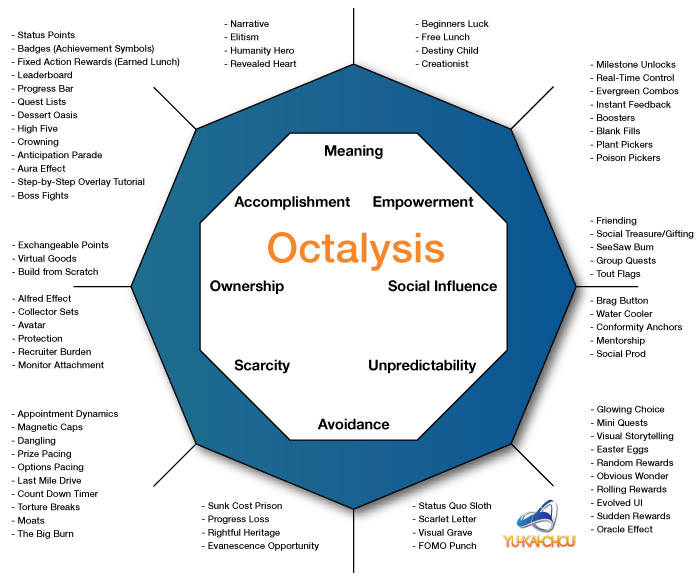
We’ve now gone through what gamification is, examples of how it can be used, and why it has a place in the parking industry. So naturally, the next question is…
How can we apply our learning to parking?
Actually, there are already several examples of gamification applied to parking! I’ll cover off a few that I’ve come across below.
Crowd Park: basically you are rewarded for finding and reporting illegally parked vehicles. It has other functionality like finding and paying for parking as well. As the owner operator, you feel like a game overlord with the ability to change pricing at will and collect the most money you can. Mua ha ha! Overall it’s a simplistic way to add gamification to parking. Screen shots from the video are below.
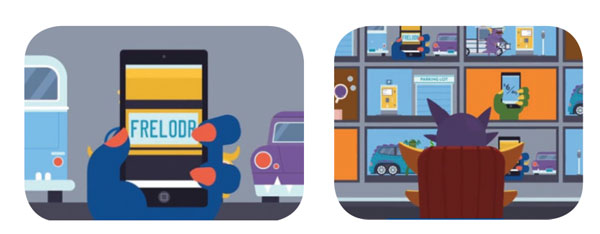
Now this example, in my opinion, isn’t a successful application. The reason I say this is because there is only one game mechanic (transparency) applied – as in, you can see someone else is breaking the rules, and report them. A few ideas on how to engage more people are awarding points for paying for a parking session with the app, offering badges for each lot the app covers, or including a leaderboard for each lot.
Parking lots as a game board: in this scenario, the lot is divided up into groups of stalls. Each group represents a different level of effort to park in, and points are awarded based on which spot you select22. For example, the 5 furthest spots from the door are grouped together, and these stalls might be worth 10 points; whereas the closest 5 stalls may be worth 0 points. This means that better stalls are available for customers or visitors. You could try this out at your own lot, and offer a coupon or discount towards future parking as a goal to work towards. And it won’t be the worst plan for customer loyalty, either.
Parkade efficiency gamification: this concept is in place in lots in India to try and curb time spent circling for parking and causing the resulting environmental damage. The application awards points based on the floor of the parkade you park on, the accuracy with which you park in the given stall, and the speed (and therefore efficiency) with which you park your vehicle upon entering the parkade23. Below is a sample point system for various levels of the parkade.

Tips for Successful Implementation
So since you’ve gotten this far in the article, I’m assuming you are at least somewhat interested in gamification. If you’re considering implementing this in your business, here are a few suggestions to help you succeed.
Personalization: making the components unique to each user captures the imagination and builds loyalty. Things like a customizable avatar or a choice within the game will create buy-in and ownership among players.
Rewards: while you certainly want to provide rewards, you need them to be meaningful. Giving out too many points or badges devalues them24. You also want to be selective about what you’re handing out rewards for. Be sure than any activity that earns a reward has a business purpose and helps you achieve a goal. Also, if you’re offering cash or gifts as rewards, be prepared for the long terms cost – if you take away the rewards at some point, you will suffer the consequences in declined participation.
Engagement: sharing the ‘why’ behind programs with people is a great trust-earning technique. It helps them understand and frame the activities requested of them in a more positive (or at least neutral) light. Emotionally engaging participants by sharing the importance of the gamified task will go a long way to securing voluntary participation.
Sharing successes:a ranking or leaderboard certainly shows others how well you’re doing. Social media posts or likes or up-votes are another word-of-mouth technique that lets the world know about your success, and validates the poster25. Others can see how many followers or retweets you receive and want to achieve the same things you are26. Adding this component to your gamification strategy is important for self-promotion of the player as well as your promotional strategy for the program.
On-demand content: this method allows users to pull content off of the platform and interact with it at their convenience27. It avoids you pushing information or tasks onto anyone, and creates a positive experience for those who want to go at their own pace.
I’ve painted a glowing picture of how and why parking should try out gamification in their parking apps and on their websites. But, it’s not all sunshine and motivated workers. Let’s explore some of the negatives.
Downsides to gamification
Cost: it can be expensive to customize and implement the technology28, especially when you include planning and training on how to use the new platform.
Cheating: winning can become all-encompassing for some people, and leads to cheating or sabotaging coworkers29. Plus we’ve all heard of hackers – don’t think your game will be immune to someone trying to cheat the system or hack your content30.
Novelty: it wears off over time, and if the game mechanics aren’t meaningful than the process will become unpopular or unused31. Any intrinsic values you’re trying to instill will be lost – or worse yet, be fake32.
Bad habits: you can run into all sorts of unexpected habits, like a competitive mindset among your staff. If users can spend real money to purchase game credits this can lead to overspending and put people into debt, seriously impacting their credit score if they get carried away33.
Trivialization: does making something a game trivialize an important issue? It has the potential to – so be careful how you present the information and what rewards you offer for participation34.
When gamification goes too far… Yes, it’s definitely possible to take it too far (in my opinion). We’ve all heard of online dating apps, but image if instead of being a vehicle to meet someone in person, it was all a game to earn points or status by being a good date?
Just to wrap up this Negative Nancy rant, I will summarize gaming expert Dr. Ian Bogost’s position. Incentives are virtual or irrelevant (where you used to get a raise, now you level up!); players are being exploited by employers35. His term for the phenomena: “exploitionware”.
Final Thoughts
Let’s wrap this gamification discussion by dispelling two myths I think might be lingering around the viability and usefulness of gamification.
Gamification is only for millennials. I don’t think so. Almost half of people over 50 play video games36, and an extremely diverse swathe of people are into gaming these days37. So really there is no age restriction on your target market. To add to my point, over 2 billion people worldwide have a smartphone38and spend around 2 hours per day online39. So not only do you have a diverse potential customer base, but they’re also already immersed in the technology you’d need to participate. The stage is set for app and website gamification with a ready, willing and able audience.
Data collected through gamification has no value. Gamification requires setting up an account and tracking and reporting progress. By aggregating this information you have access to a vast amount of data you would have never been able to find out otherwise. Things like exactly when, where, and how often people use your services. You can send targeted marketing directly to people who are most likely to respond. You can also use social media connections to broaden your audience and reach.
In the end, whether or not you give consideration to gamifying your parking tech is up to you. I’m only here to provoke some thought around a topic you may not have considered, and provide information to anyone who’s willing to read. If you still want to learn more about gamification, you can take a free online learning course from the University of Pennsylvania. It’s run through Coursera so you’ll need to sign up for a (free) account. If you’re interested, check out the course at this link, and get started! https://www.coursera.org/learn/gamification
- http://www.bunchball.com/gamification
- https://www.slideshare.net/dbenoni/gamification-of-engagement-culture/49
- https://www.slideshare.net/dbenoni/gamification-of-engagement-culture/49
- https://explorable.com/16-basic-desires-theory
- http://s3.amazonaws.com/academia.edu.documents/31229679/CHI-GamificationDesign_GEARS.pdf?AWSAccessKeyId=AKIAIWOWYYGZ2Y53UL3A&Expires=1500914917&Signature=MwCEczxCWs7XELq6d27%2FFrZUkig%3D&response-content-disposition=inline%3B%20filename%3DGamification_in_Business_Designing_Motiv.pdf
- http://www.bunchball.com/gamification/game-mechanics
- http://hcigames.com//www/wp-content/uploads/2015/01/The-Kaleidoscope-of-Effective-Gamification-Deconstructing-Gamification-in-Business-Applications.pdf
- http://technologyadvice.com/gamification/
- http://technologyadvice.com/gamification/
- http://www.businesswire.com/news/home/20110603005279/en/Keas-Introduces-Power-Play-New-Online-Health
- https://elearningindustry.com/6-killer-examples-gamification-in-elearning
- http://theconversation.com/how-gamification-can-make-transport-systems-and-choices-work-better-for-us-57663
- http://www.masstransitmag.com/press_release/12270742/gamification-in-public-transportation-passengers-quit-using-own-vehicles-and-participate-in-ecological-competition-based-on-kilometers-of-bus-travel-measured-by-onyx-beacons
- https://www.fastcodesign.com/3063463/slicker-city/one-ambitious-plan-to-ease-overcrowded-trains-pay-the-riders
- http://web.stanford.edu/~balaji/papers/13INSINC.pdf
- http://www.mobilityspeculations.com/bluechallenge/
- I’m not joking. Proof: https://en.wikipedia.org/wiki/KISS_principle
- http://metro.legistar1.com/metro/attachments/6ef407e8-47bf-4ab6-993c-fd8de4b6a17f.pdf
- http://www.destinationcrm.com/Articles/Columns-Departments/Reality-Check/The-Pros-and-Cons-of-Gamification-86626.aspx
- http://metro.legistar1.com/metro/attachments/6ef407e8-47bf-4ab6-993c-fd8de4b6a17f.pdf
- http://yukaichou.com/gamification-examples/octalysis-complete-gamification-framework/
- https://www.juiceinc.com/files/documents/JUICE_SUCCESS_STORY_DD2014_v3.pdf
- http://www.ijcaonline.org/archives/volume144/number10/duggal-2016-ijca-910444.pdf
- https://elearningindustry.com/3-mistakes-youre-making-gamification-business
- http://www.alterisgroup.com/blog/gamification-techniques/
- https://techcrunch.com/2012/11/17/everything-youll-ever-need-to-know-about-gamification/
- http://www.alterisgroup.com/blog/gamification-techniques/
- https://tophat.com/blog/gamified-learning/
- https://www.nirandfar.com/2014/09/its-not-all-fun.html
- https://ryan2point0.wordpress.com/2015/03/16/the-dark-side-of-gamification/
- https://www.nirandfar.com/2014/09/its-not-all-fun.html
- https://www.slideshare.net/dbenoni/gamification-of-engagement-culture/49
- http://www.destinationcrm.com/Articles/Columns-Departments/Reality-Check/The-Pros-and-Cons-of-Gamification-86626.aspx
- https://ryan2point0.wordpress.com/2015/03/16/the-dark-side-of-gamification/
- http://www.bbc.com/news/business-17160118
- http://www.huffingtonpost.com/2013/11/18/baby-boomers-video-games_n_4297675.html
- http://www.popmatters.com/post/baby-boomers-video-games/
- https://www.statista.com/statistics/330695/number-of-smartphone-users-worldwide/
- http://www.fiercewireless.com/wireless/how-much-cellular-and-wi-fi-data-are-smartphone-users-consuming-and-which-apps-verizon-0


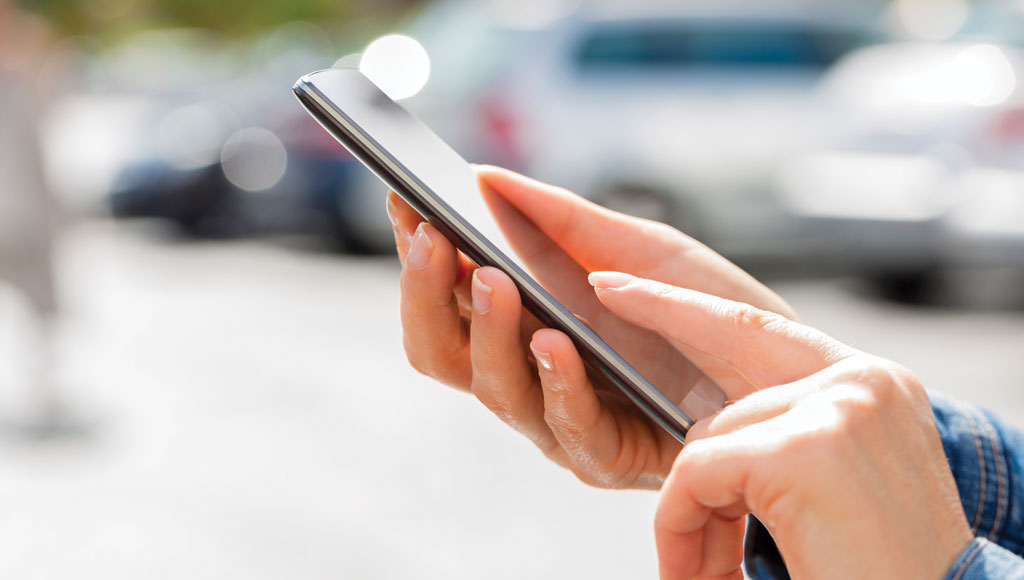




I agree gamification apps is the best tool to engage users. Thanks for sharing.